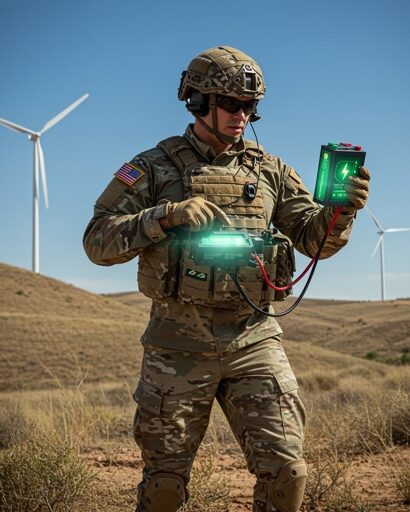Abstract: The multi-domain battlefield does not “know” any boundaries or limits. Instead, it requires constant adaption and reconfiguration through all dimensions, covering civilian and military “worlds” simultaneously. The concept of mosaic warfare, originally developed by the US Marine Corps, focuses on decisiveness using technology innovatively for the benefit of systemic effects. This paper argues, that the mosaic warfare concept poses a valuable approach to cope with the “entgrenzte” multi-domain battlefield and examines the preconditions needed for the German Armed Forces to foster innovation within the context of personnel, organization and technology. The logic of innovation within this concept is considered to be cause and consequence.
Problem statement: How to enable the German Armed Forces to conduct a new way of warfare, called mosaic warfare?
Bottom-line-up-front: Mosaic Warfare relies on innovation which has to be enabled within a strategically framed ecosystem of leadership, training, institutions and permeability to civilian and military academic as well as start-up environments.
So what?: The German Armed Forces own favorable conditions to incorporate the main ideas of mosaic warfare with Mission Command, academic education, a growing culture of intrapreneurs and numerous innovation actors. However, a strategic frame, incorporating a culture of doing and connecting the dots is still missing.

Source: shutterstock.com/Toria
Rethinking War and Conflict
“The Russians Lost An Entire Battalion Trying To Cross A River In Eastern Ukraine…,” writes Forbes magazine about the destruction of approximately 100 military vehicles and 1000 soldiers at the Siverskyi Donets River crossing point and elaborates further: “The Ukrainian army’s 17th Tank Brigade spotted the bridge, perhaps using one of the many small drones that function as the army’s eyes over the battlefield.”[1]
The Russians Lost An Entire Battalion Trying To Cross A River In Eastern Ukraine…
A scenario like that described above is tragic, albeit expected in a conventional conflict. What is remarkable in the case of this unsuccessful river crossing is that Ukraine, seemingly militarily and technologically inferior on paper, has repeatedly succeeded in inflicting massive casualties on Russian forces through the efficient use of off-the-shelf systems on the ground and in the air, combined with an improvised battle management system supported by civilian software.[2]
This asymmetry between apparent and real military capabilities raises three questions: how are superior operations justified on today’s battlefield; what exactly is the battlefield; and?This paper argues that innovation provides the right incentives and intellectual base for the German military in order to cope with the challenges and questions raised above.
In that sense, innovative thinking and acting in a military sense is understood from the authors’ perspective as a cultural and intellectual paradigm fostering a mental attitude that facilitates the adaptivity and flexibility that makes tactical-operational leadership better and brings about a constant organizational and technical renewal of the overall organization. The term innovation refers to a dynamic approach to thinking and acting, as well as the search for new and proven ideas in expanded contexts and the consistent implementation of these very ideas. Such an attitude is characterized by appreciating the better idea without envy. This overcomes any boundaries[3] or consolidates them in new contexts with the objective of improvement.
The guiding principle here is the notion that even the latest technology will not bring about a decisive advantage in the future if it only enhances existing concepts. Nor do rigid processes and management methods oriented toward safeguarding and formalization promote superiority on the battlefield. Rather innovation can generate sufficient adaptivity for the German Military. That is why this paper will discuss the need for innovation related to the requirements of an unbordered battlefield first-hand and continues with an examination of its meaning related to the concept of mosaic warfare. It will close with recommendations for the German armed forces on how to achieve an innovative condition in which mosaic warfare can be implemented.
Security And Operational Challenges Of A Multi Domain Battlefield (MDB)
Imagine There Is A War, And Everyone Is Involved – Indicator MDB I: Hybridity
It could begin like the fictive situation stated below:
- A conflict that is permanently smoldering with unattributable digital and physical attacks against civilian and military infrastructures […]
- financial systems, communication networks, facilities for primary and health care routinely become the target of attacks and breakdown […]
- disinformation campaigns, especially those using social media, aim to delegitimize the elected government and stakeholders[4][…]
- Protest movements within the home country are initiated and supported by external players […]
- opposing and covert forces carry out attacks and disruptive actions […]
- a parallel massing and tactical positioning of forces, supposedly declared as an ‘exercise,’ is carried out to set the stage for an attack on the home territory […]
“On Day X, an attack occurs in the overall network of all dimensions at once, i.e., air, sea, land, cyber, information, and space. Navigation and communication networks cease to be accessible […] chaos reigns, and protection of civilians becomes impossible […], and the civilian population and government apparatus in particular are simultaneously targeted […] the enemy deploys, among other things, a network of conventional monolithic systems and airborne capabilities.”
On Day X, an attack occurs in the overall network of all dimensions at once, i.e., air, sea, land, cyber, information, and space.
This scenario, which became a partial reality with the Russian attack on Ukraine on February 24, 2022, highlights the contours of contemporary and future warfare.[5] A national and international legal categorization of the enemy’s actions, which would legitimize their civilian and military response, only becomes possible with the outbreak of open conventional hostile activities. “Red” lines, i.e., legally defined and socially recognized lines denoting a war as such, are purposefully subverted over a period that cannot be measured in time.[6] The opponent “acts” with the involvement of their military, civil, economic, and academic resources with deceptions, sanctions, maneuvers, and narratives,[7] to establish their interpretational jurisdiction and latently asserting their own will or preparing for its implementation.[8]
As a result, this political-military confusion creates a national and international situation characterized by uncertainty, making it difficult to identify the actual cause(s) of systemic frictions, which in this case is a long-term plan to assert one’s own (power) interests. The hybrid “keyboard” of a state actor is not only operated with all its military and civilian affordances, but is constantly reconfigured in its means and intensities to hamper any appropriate response.[9] The element of simultaneity between covert and overt attacks with varying intensity in all dimensions leads to excessive demands on one’s own, i.e., a democratic state like Germany and its constitutional founded separation of internal and external security.
The element of simultaneity between covert and overt attacks with varying intensity in all dimensions leads to excessive demands on one’s own.
The current situation in Ukraine, through its escalation over many years and its transition into an openly vicious war, constitutes a turning point and, at the same time, a “blueprint” for the profile of future conflicts. However, it also becomes apparent that pure military-economic superiority (on the part of Russia) and a perceived dominance in the use of hybrid methods will not automatically lead to the successful or rapid enforcement of one’s interests. Consequently, the actions of Russia and the reactions of Ukraine in this conflict on a battlefield without boundaries must be examined in terms of the elements that justify “superiority” and advantage.
Complexity Is Our Future…Indicator MDB II: Dissolution Of Boundaries
Conflicts of all kinds around the world, and with them a potential unbordered multi-domain battlefield, are becoming increasingly characterized by the dissolution of boundaries, which also carries with it an increase of the conflict’s complexity.[10], [11] The lack of distinct military targeting means that a conflict that is limited to one “place” in terms of space, time and/or legal status based on previous notions of sovereignty[12] is hardly possible anymore. Aggressive action in the sphere of information, in the form of cyberattacks against civilian elements through attacks against supply-relevant economic lines remote from one’s territory by a state actor, even over a longer period, represent only selected examples of the complexity of hybrid warfare.
One consequence is that the civilian part of society not only becomes the target of attacks and, as a result, part of a “battlefield,” but also increasingly becomes established as an independently operating player with its own means of action and interests in the conflict itself.[13] The players in this type of conflict are no longer just tech giants, private military companies, or business groups[14] but also parts of civil society itself. This circumstance entails direct implications under international law stressing the distinct separation between peace and war through the development of paramilitary structures and potential in the civilian sphere. These structures, for example, in the digital sphere in Germany, already exceed the capabilities of state (military) action in part due to their quickly activated networked areas of knowledge, life, and action.
The increasing complexity and dynamics of conflicts, which can span decades, highlight that the military can only help resolve conflicts in partnership with civilian players at all levels and all professions. It is also clear, especially in light of the rapid technological developments, that the necessary intellectual and financial resources are primarily located in the civilian sector, leading to a one-sided dependency between the military and the civilian sector.[15]
The increasing complexity and dynamics of conflicts, which can span decades, highlight that the military can only help resolve conflicts in partnership with civilian players at all levels and all professions.
The fact that an entire society can become the target of attacks on a cognitive, physical, digital, and social level necessitates a counter-response that can be consistently adaptive and dynamic, consolidating its limited resources in the civilian and military spheres at the right levels and the right junctures, and applying them to the right effect: in the view of the authors, it is precisely this challenge of the MDB that provides the basis for an innovative mindset and ecosystem as shown in the graphic.
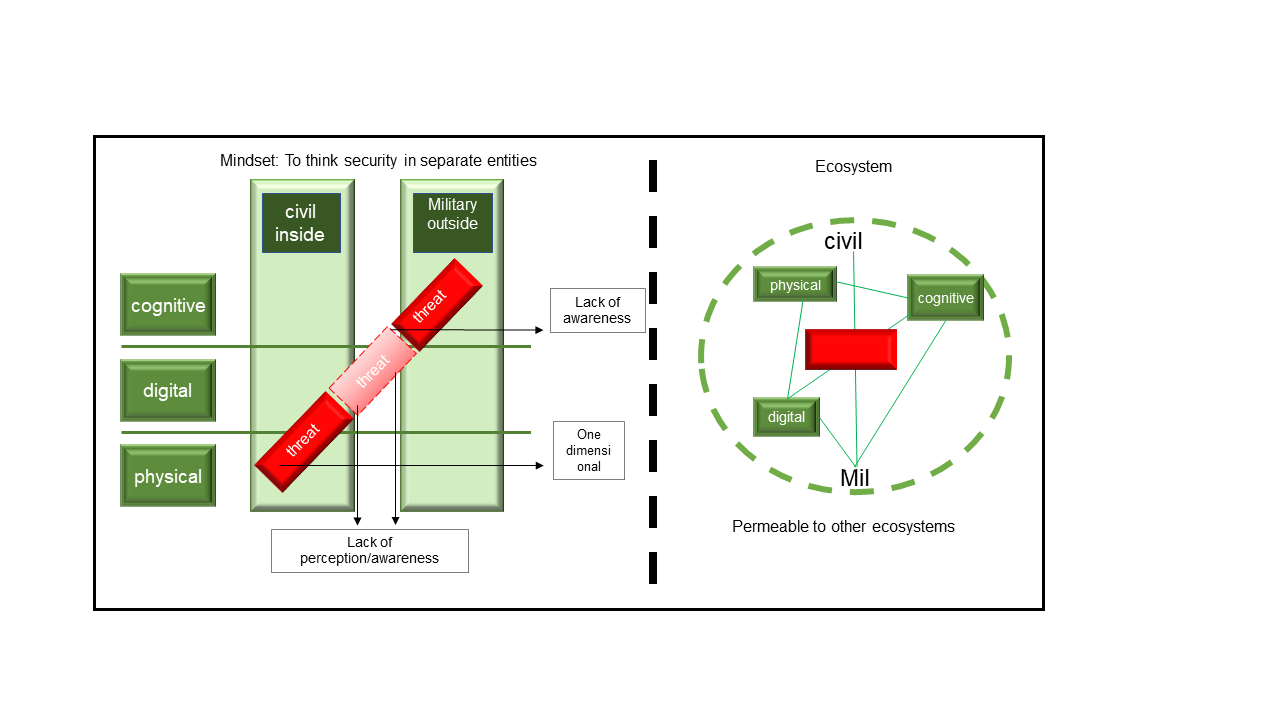
A simplified comparison of thinking in (seemingly) deconfined spaces and a problem-oriented comprehensive approach without departmental/sectoral thinking.
To sum up, Germany but also all other states bound to a national and international legal system, are already confronted with an operational environment that is characterized by:
- Lack of boundaries;
- Chaos;
- (Equal) temporality;
- Complexity; and
- Hybridity.
The characteristics of the MDB outlined require, in the context of their breaking down of boundaries and the high dynamics of technological development with limited resources,[16] a new way of thinking about warfare and conflict management that transcends a dichotomy of civil-military, peace-war, science-military – pillars as shown in the graphic become obsolete.
Mosaic Warfare And Innovation
Manifestations of warfare and conflict management within this deconfined battlefield are permanently being transformed due to technological developments.[17] Increasing automation or implementation of technical so-called assistance systems in combination with high-speeds, high-precision, and lethality has been increasingly characterized armed conflict. The objective of current warfare is to slow down the opponent at all levels of the decision-making process, making the decision and consequently their action either too late or completely absent.
Forms of expression that are employed in this warfare include the use of partially or fully automated modular, smaller systems developed with a low expenditure of resources, also as dual-use, which are produced and used in large numbers. Those entities can be employed as unmanned vehicles (UVs) in all physical dimensions.
“Unmanned Aerial Vehicles (UAVs) also become all the more interesting for use in multiple domains of the hybrid conflict field due to their multi-role capability. They can be used for intelligence, surveillance and reconnaissance (ISR) missions just as they can for kinetic attack operations.”[18]
The impact of UAVs as an interoperable platform, in the interplay of different highly automated systems, may take place across dimensions and allows the equipment to become adaptable at any time, in accordance with the environment and the task at hand. The use of such systems is an alternative to high cost-, time- and development-intensive systems and facilitates the flexibility and adaptivity that an MDB requires. Such systems require reciprocal ad-hoc networking in a cloud or edge-based network for communication and control (C2).[19] In other words, highly automated systems exchange data with each other for coordination and feed the data live for evaluation by other intelligent systems or by humans.
UAVs also become all the more interesting for use in multiple domains of the hybrid conflict field due to their multi-role capability.
The speed of decision-making is also of key importance: the faster one can run through one’s own OODA loop[20] and make a decision, the higher one’s potential assertiveness. Massing monolithic systems under central command with large and stationary leadership facilities will become less important, especially when facing an equally capable opponent.
The concept of Mosaic Warfare represents an approach to (re)thinking and tactical-operational action based on modular, functional, and networked platforms under the framework conditions of the MDB. The US Defense Advanced Research Projects Agency´s (DARPA) Strategic Technology Office proposed the concept for the development of forces and operations for 21st-century superior maneuverable warfare.
A Mosaic system has to be designed so that it can be flexibly networked and quickly configured to provide the actor with robust networked capabilities. Much like the pieces of a mosaic, any system (or any unit) that has the necessary functional characteristics can be combined with others at any time to provide the desired operational value for generating a predefined effect at a desired time and place of choice. Based upon a high degree of flexibility in thinking, Mosaic Warfare requires a command and control culture of mission command.
The core concept of Mosaic Warfare lies in modularity and, consequently, continuous reconfiguration. This characteristic goes beyond a purely technical component and has to be reflected in operational concepts capable of incorporating it in terms of flexible scaling, interaction, networking, and flexibility. Mosaic Warfare combines the tactical with the operational level and is aimed at impacting the enemy’s (overall) system. The prerequisite for applying this concept entails an adaptive, flexible, and dynamically creative mindset that thinks and acts holistically. This creative mindset is fundamentally linked to the action imperative of experimentation and implementation: trial-and-error with the enduring goal of improvement.
The German Bundeswehr is presented with a special opportunity when it comes to the implementation of Mosaic Warfare: the historical lack of a dedicated national operational level and command culture capable of commanding several divisions simulteanously[21] means that the Bundeswehr could become a pioneer in the application of this concept. Innovation becomes a prerequisite and catalyst for the concept of Mosaic Warfare.
The historical lack of a dedicated national operational level and command culture capable of commanding several divisions simulteanously means that the Bundeswehr could become a pioneer in the application of this concept.
Innovation And Strategy
Innovative thinking sui generis must be geared towards transcending existing mental boundaries between civilian and military.[22] We must constantly draw new incentives from existing, often limited resources and take a forward-thinking and adaptive stance in the face of the enemy’s reconfiguration. This innovative fundamental approach also becomes an essential multiplier for security that is applied to society as a whole:
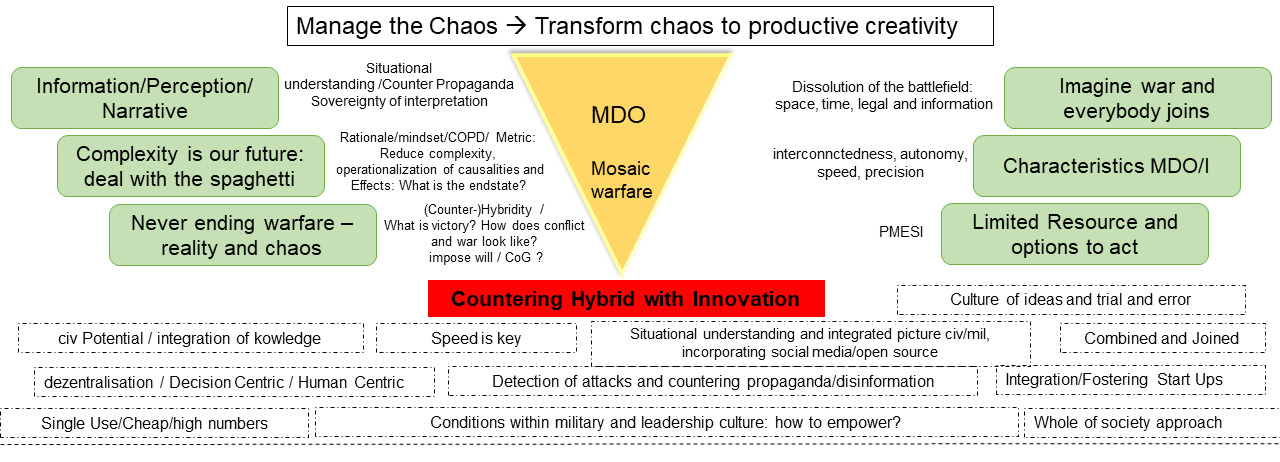
The diagram illustrates the security policy framework conditions and derivations for the MDB in the context of innovation.
Innovation And Strategy – Enable Innovation
An innovation strategy puts the resources of technology, personnel, and organization into a mutual long-term relationship. It generates framework conditions aimed at achieving the end state: The Bundeswehr networked in a societal innovation ecosystem that generates innovation from itself and facilitates exchange with open civilian systems to meet the challenges of MDB 2040 with Mosaic Warfare.[23] A strategy sets a prioritization with the objective: it defines in which area innovations are to be fostered and with which resources for which end state.[24] For that reason, innovation is designed to have a concrete benefit and value for the armed forces.[25]
“Innovation isn’t about ‘ideas.’ Innovation is always tied to the ability to perform, execute and deploy.”[26]
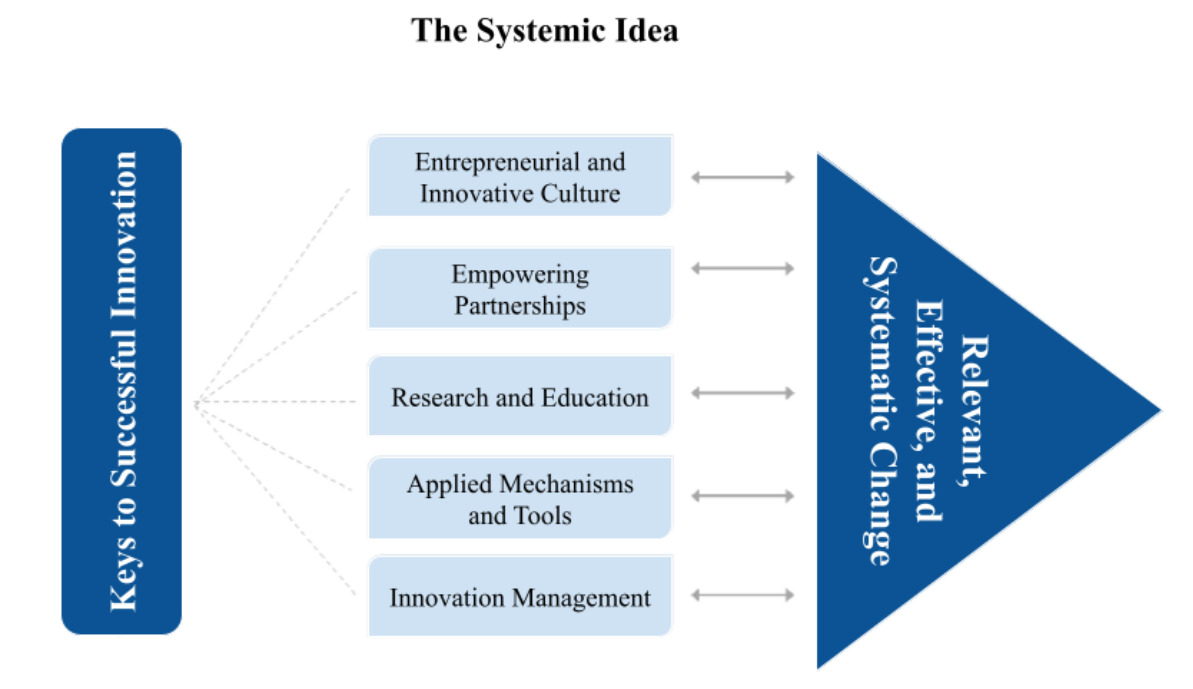
Innovation – The Systematic Idea
In this respect, the innovation strategy functions as a framework in which the individual activities and areas aspire along the same lines – towards an innovation ecosystem.[27] An innovative mindset is based on an attitude that has to be inherent in the training of the soldiers: the courage to try things out, think, and engage in discourse. It is here that the lived principles of inner guidance come into play. Not every soldier or superior will become someone who is an “intrapreneur,” but it is important to nurture this adaptive mindset for the benefit of the armed forces.
This approach is far removed from thinking about boundaries and pure professionalism. In other words, connections must be made and exchanges established between departments, military-civilian, divisions, and institutions. The quality of the problem dictates the number of players involved, not the competence. Universities and training institutions are of particular importance here, instilling the right mindset and providing a secure space as a testbed.[28]
The quality of the problem dictates the number of players involved, not the competence.
A common understanding of innovation plays a fundamental role in the success of a long-term innovation strategy which requires the involvement and commitment of all members of the Bundeswehr.
A Bundeswehr Innovation Ecosystem?
The further development of structures currently in place in the Bundeswehr with different specialist orientations (KVP, FuT, CD&E, non-technical studies) tend to administer innovation rather than drive it themselves in terms of content.[29]
Considering the challenges described here, an efficient innovation ecosystem[30] within the Bundeswehr must be structured such that, in addition to the necessary administration, the self-creativity and innovation concepts within and from the troops, as well as other military and civilian innovators, are taken into consideration, promoted, supported and implemented on time.
The innovation ecosystem requires a strategic realignment that stipulates the setting of focal points, prioritization, and resource management for innovation projects. The institutions responsible for innovation management have to endeavor, according to uniform criteria but with maximum flexibility, to identify innovations at an early stage, utilize synergy effects and knowledge potentials and, above all, strive for rapid and scalable implementation while tolerating setbacks. The administrative expenditure associated with innovative progress has to be run by an experienced small administrative organization capable of handling this and focusing on innovation support. The innovator has to be relieved of administrative tasks to the greatest extent possible rather than becoming burdened with them, which is currently the case. The exchange and integration of civilian and military potentials, e.g., through joint ventures or “spin-offs,” are just a few examples of this.
The benchmark for the performance of the innovation ecosystem continues to be the time component, idea-ownership of the innovator, and ultimately the usefulness for the armed forces. The prerequisites in the context of Mosaic Warfare lie in the permanent further development of platforms, which are currently generating their potential, especially from the civilian start-up scene.[31] A connection to this area through networks is thus crucial for integrating this civilian innovative potential.
The prerequisites in the context of Mosaic Warfare lie in the permanent further development of platforms, which are currently generating their potential, especially from the civilian start-up scene.
A strategically conceived innovation ecosystem calls for a top-down approach within the framework of which supportive framework conditions can be established along common goals. Yet a bottom-up approach from the troops is also required, as well as holistic structures that facilitate an exchange with the civilian environment. In this case, institutionalized or ad-hoc networks with civilian and military thinkers and innovators are decisive. These networks, which are based on mutual understanding and trust, are capable of responding to problem-specific situational developments within a short time and without structural restrictions while taking into consideration necessary and proven compliance processes and, where applicable, generating impulses for further developments or providing support in countering operational challenges.
“There are always more smart people outside your company than within it. If you wish to work with others and cooperate with them, you must adopt an open innovation culture.” – Bill Joy[32]
The Bundeswehr as an institution has to position itself in a way that generates, identifies, and links innovation players internally and externally and permanently creates formats of exchange with the civilian sector (horizontal networking).
A strategically aligned innovation landscape not only networks at the national level but also establishes a European security and innovation architecture interconnected via a knowledge transfer cloud.[33] The concept of open innovation, transcending national borders and exchanging with a worldwide network of innovation centers, universities, research institutes, and enterprises ought to be the guiding principle in this instance.[34] The cultivation and advancement of communities of practice in this context represents a clear added value, “because they can react quickly to even the smallest changes thanks to their proximity to the respective specialist field and the networking of acknowledged experts and highly committed comrades-in-arms.”[35]
Personnel And Mindset
It is precisely leaders who, in the face of a high degree of uncertainty and complexity, have the social, characteristic, and professional competence to reach comprehensible solutions – and to convert them into responsible, goal-oriented action – that are needed in order to survive in today’s multi-domain battlefield, which will become even more complex in the future, alongside the institutions and structures. Military action in the face of uncertainty continues to demand mental agility, courage, and adaptivity. In an uncertain context, innovative thinking and action mean being creative, dynamic, and reflexive. Both elements together represent optimal implementation.
Innovative leadership not only requires the will to shape things but also the readiness to make or accept mistakes to learn from them for the future and improve the armed forces. Nevertheless, decision-making and action alone are not enough to achieve the right. It is also important to reflect on one’s own systemic (thinking) structures and processes and actively develop them further. It is much more important to rethink what is tried and tested in changing contexts and to embrace new ideas – this requires curiosity, courage, and a healthy risk appetite – all united under the common goal of being ultimately superior as a military leader also on the MDB. Key elements of inner guidance are touched upon, which in particular leaves the decision-making authority at the level that bears the responsibility and has the relevant information, building on a foundation of trust.
Innovative leadership represents a decisive gain in time within the context of the challenges in the decision-making process of multi-domain operations (MDO):
- Likely lack of connectivity in future operational environments has shifted the paradigm from Network-Centric to Human-Centric (Mission Command) though global information environment is also the umbrella and reachable in discrete space-time patterns.[36]
The concept of mission tactics and the premises of inner guidance in combination, therefore, represent an essential point of connection to MDO. Taken together, they facilitate a value-based, innovation-friendly environment, which in turn enables swift, proactive, autonomous decision-making within the framework of MDO. This implication underlines the mission and the claim of military training institutions for implementing the premises of inner guidance, especially in the training of future leaders. The Bundeswehr’s Staff College is particularly important in this context, given its special role as a think tank and workshop for the future.[37]
The concept of mission tactics and the premises of inner guidance in combination, therefore, represent an essential point of connection to MDO.
Prerequisites And Individual Measures In The Areas of Technology, Personnel, And Organization
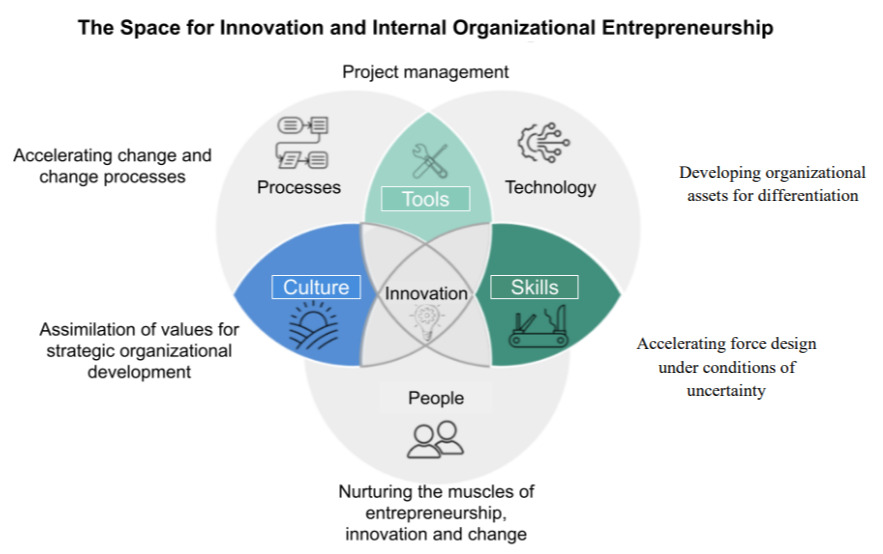
Source: IDF Innovation Strategy[38]; The diagram depicts the interrelationships between the areas of technology – organization/ processes and personnel and illustrates the importance of a comprehensive approach to promoting innovation.
Technology
Taking into account the technical challenges confronting the Bundeswehr today, the following elements will be important – true to the motto: dare for more troops.
- Solutions available on the market are to be used as (interim) solutions or minimum viable products so that capability gaps can be closed in the short term and experience values can also be incorporated into one’s own developments.
- The same applies to services rendered by the civilian sector, particularly software solutions, since in-house development expertise cannot keep pace with solutions available on the market.
- Technical solutions are oriented towards defined problem descriptions and conflict scenarios. The procurement of equipment or IT does not constitute an end in itself but is geared towards dealing with possible scenarios – special emphasis should be placed on the skills of those involved, who often have a pragmatic view of potential solutions.
- There is a need to harmonize and standardize efforts to create innovation radars[39] and/or maps so that military and civilian developments can be kept in view. A central app solution allows for the integration of various players, creates a common situational picture and contributes to the exchange of knowledge/data, including within the Federal Armed Forces organization.[40]
- Procurement/armament cycles are to be avoided as a rigid requirement. Renewals need to be aligned with the potentially fast-moving need for adaptation, meaning changes in the system environment, rather than with administrative regulations on life cycle management.
- Cooperation with industry has to be oriented towards future scenarios, previous experience values of users in procurement (especially for time savings) have to be taken into consideration.
- In the case of larger procurement proposals, minimum viable products, as well as further iteration steps, have to be tested and evaluated with users in parallel to the development. The findings gained are to be implemented by the industry, and MVPs are to be released for (limited) use on a scale that is appropriate and measurable for the troops. This requires that the involved units be provided with resources and the ability to adapt.
Organization
The following aspects are to be implemented on the organizational side in the current understanding:
- Out of the many units that now have “innovation” in their name, a SPOC becomes necessary from the user’s perspective. This functions primarily as a space for the troops to address ideas and engage in an initial exchange. The multifaceted organizational responsibilities within the Federal Armed Forces (not looked at here) are of secondary importance in this respect, no longer hindering idea generators and potential users with the respective diffusion of responsibility and bureaucracy.
- The visibility of innovation projects within the Federal Armed Forces needs to be increased. This means specifically the internal communication within the force and, above all, the communication with (potential) users as well as those involved in the development, in order to encourage further ideas as well as the motivation of members of the armed forces on the one hand and to encourage further potential users within the organization through progress reports on the other.
- Established thematic, regional and also international competitions of ideas,[41] where users and intrapreneurs especially also compete against industrial solutions, underlining the point mentioned above and highlighting the potential for innovation needs of the armed forces.
- Awards or nominations by the highest military levels raise visibility, enhance motivation and clarify resonance.
- The Federal Armed Forces are opening up more to the start-up scene and the university landscape, incorporating them into test and trial structures and facilitating competition even against large armament corporations. Existing regulations should be reviewed for their adaptability.
- Test and trial structures in the respective service/Teilstreitkraft and Organisationsbereich should be migrated to joint force centers (Systemhäuser) in order to identify and prevent thinking along dimensional lines as early as during testing and evaluation.
- For an institutionalized consolidation of academic potential, innovation culture and military experience or needs, an innovation academy, e.g. under the leadership of the CIHBw, will be installed. This academy acts as an impulse generator for innovation in the armed forces. Its training and further development programs are aimed at superiors and intrapreneurs from the military and civilian sectors.
- Targeted micro-projects with start-ups are to be supported with financial resources for a limited period of time if necessary – by all means also in the sense of venture capital. This also applies to innovation projects within the Federal Armed Forces. There must be ways of ensuring that promising MVPs can be quickly implemented and further developed in the armed forces along scalable lines.
- The prerequisite here is an open and recurring exchange between civilian and military players in the sense of an ecosystem. Actors from the Federal Armed Forces, universities, industry, start-ups, training and research institutions are familiar with each other and exchange information on their projects. To achieve this, regular institutionalized exchange formats are essential in order to also form ad-hoc networks to address topics.
- Innovation islands in units or large associations that primarily bring together local civilian and military intra- and entrepreneurs for solving problems.[42]
- The Bundeswehr cultivates its own type of change management as well as trial and error culture.
Personnel
The following aspects must be taken into account when it comes to our personnel in order to create an environment conducive to innovation:
- The principles of inner guidance are also applied to innovation. They are, therefore, an integral part of the training. Dealing with innovation in the Federal Armed Forces and the players involved are integrated into the training and established as a topic that recurs in the training of commanders.
- Intrapreneurs in the Federal Armed Forces are identified early on, and the troops are encouraged to contribute their ideas. Administrative hurdles must be identified and overcome. Incentive systems should be created where possible.
- A mentoring program – e.g. involving course participants from the Federal Armed Forces Staff College – should be provided for younger intrapreneurs.
- Idea generators support their ideas and projects even if their post changes. This idea of ownership contributes to the overall quality of the result as well as to the motivation of the personnel.
- Awards and best prizes for innovators in the Federal Armed Forces are awarded on a recurring basis.
- Space for innovation can be created and/or used by superiors; it is essential to both have and take time here.[43]
- Military-Academic careers are established as an option.
Conclusion
An appropriate response to the fast-changing unbordered battlefield requires adaptivity and a risk-prone attitude on all levels: institutional, cultural and strategic. This change in behavior needs to take place comprehensively at all levels and consider a mutually dependent interrelationship of thought, communication and action embedded in an innovation strategy that sets out clear goals.
An appropriate response to the fast-changing unbordered battlefield requires adaptivity and a risk-prone attitude on all levels: institutional, cultural and strategic.
As described by the concept of Mosaic Warfare, future warfare implies that the innovation potential of intrapreneurs and the start-up scene must be actively integrated. Mosaic Warfare follows the logic of responding to intended instability and confusion with chaos (Balagan). It requires the cultivation of highly dynamic and problem-oriented thinking in categories of systemic effects. The actual composition of a “swarm” depends on the problem and the context. The more important issue relates to the facilitating framework conditions of a society and a defense landscape that is capable of “sustaining” the mosaic warfare concept. In light of the current formalized structure within the Bundeswehr in deconfined areas and a procurement process spanning extremely long timelines, it will be difficult or impossible to implement this – an initial starting point could be the authors’ recommendations for action outlined here. We need to further consider what kind of armed forces would be needed that are capable of Mosaic Warfare – the Bundeswehr could be a pioneer in this field.
LTC Daniel Ulrich, Graduate from German General Staff Class of 2020, current position at the Staff of the German Military Representative to NATO/EU Military Committee at Brussels. LTC David Wolf, Graduate of German General Staff Class of 2020, current position at German Joined Forces Command at Potsdam. LTC Josef Kranawetvogl, Graduate of the German General Staff Class of 2020, current position at the German Ministry of Defense. The views contained in this article are the authors’ alone and do not represent the views of the German Armed Forces.
[1] David Axe, “The Russians Lost An Entire Battalion Trying To Cross A River In Eastern Ukraine,” Forbes Magazine, 2022.
[2] Gregory C. Allen, “Across Drones, AI, and Space, Commercial Tech Is Flexing Military Muscle in Ukraine,” Center for Strategic and International Studies, 2022: “Ukrainian forces have used 3D printers to add tail fins to Soviet-era anti-tank grenades. When dropped from an overhead commercial drone, these cheap and simple munitions can penetrate the relatively weak roof armor of Russian tanks and other vehicles. This innovative combination of cheap commercial and military technology offers a useful capability that can destroy Russian vehicles costing hundreds of thousands or millions of dollars for the price of a $100 grenade and a $1,000 drone.”
[3] Formal structures and hierarchies such as resort, disciplines, subject related etc.
[4] Kubo Mačák, Tomas Minárik, Tatana Jančárková, “Scenario 01: Election interference,” https://cyberlaw.ccdcoe.org/wiki/Scenario_01:_Election_interference; Julien Lindley-French, John R. Allen, Frederick Hodges, “Future War and the Defence of Europe: 5-D Warfare: “Disinformation, deception, disruption, and destabilization combined with the threat of mass destruction to intimidate…”,”(Oxford University Press, 2021), 9.
[5] Julien Lindley-French, John R. Allen, Frederick Hodges, Future War and the Defence of Europe: „AI, deep learning, natural language processing, computer vision, and other related characteristics, super-computing, eventually quantum computing, and nano and biotechnologies, advanced big data analytics, and other emerging technologies are beginning to offer an entirely new way of war…”, Oxford University Press, 2021, p. 30.
[6] Red Lines are not necessarily codified laws but also demonstrate a political will to act and to sanction certain behaviour. (Or the lack of it).
[7] A comprehensive and well-illustrated overview of Russian Propaganda can be found at: https://euvsdisinfo.eu/.
[8] “Detect and Understand Modernizing Intelligence for the Gray Zone,“ https://www.csis.org/analysis/detect-and-understand-modernizing-intelligence-gray-zone.
[9] The spectrum of an escalation could cover low intensity (grey zone) up to high intensity (conventional war). The term „hybrid“ is discussed in many ways. Every conflict bears entities of hybrid. That is why the focus should be on HOW hybridity is being used to cause destabilizing effects. “Hybrid Warfare is an old phenomenon, which today is significantly empowered by new technological developments. New technologies, with their disruptive potential, have a catalytic effect on hybrid means, methods, tactics and strategies.”
[10] Lindley-French, Julien/ Allen, John R. / Hodges, Frederik Ben, Future War and the Defence of Europe: Another major war in Europe might be “hyper war”: […] …ultra-fast warfare that combines a myriad of systems… AI would not be a stand-alone technology, but act in concert with machine-learning, human enhancement, genetic manipulation, data analytics, simulation, behavioural science, drone technologies, quantum-based sensors,” Oxford University Press 2021, 217.
[11] In addition to the concept of MDB, one should consider Multi-Domain Integration as well: (UK MoD 2022) “Multi-Domain Integration (MDI) is about ensuring that every part of defence can work seamlessly together, and with other government departments and … allies, to deliver a desired outcome. … MDI will not happen by accident, and Strategic Command as defence’s integrator is responsible for implementing this change.”
[12] Martin C. Wolff, “Digitale „Souveränität“?,” The Defence Horizon Journal, “Fights for internal sovereignty are fights to gain means of force whereat external fights for sovereignty are the fight with them. This implies for a digital world that clashes exceed the traditional dichotomy of police and military and reach deep into the private sector.”
[13] The legal aspects and implications of combatants and non-combatants according to the international law of armed conflict will not be discussed at this point. An example of civil actors who participate voluntarily in armed conflicts is the hacker group Anonymous. Further questions regarding the involvement of civil actors could be incorporating aims, loyalty, motivation, and values.
[14] Elon Musk´s network of small and civil-launched satellites (STARLINK) is an example.
[15] An overview of sources of innovation is provided in: “The 100 greatest innovations of 2021. The 34th annual Best of What’s New awards,” https://www.popsci.com/technology/best-of-whats-new-2021/.
[16] German Foreign and Security Policy has a clear priority on diplomacy and economic means in comparison to the use of military means. The elements of DIME are not balanced equally.
[17] An example poses the conflict between Azerbaijan and Armenia in 2021.
[18] Christian Frank Sprengel, “Drones in hybrid warfare, Lessons from current battlefields,” Hybrid CoE Working Paper 2021.
[19] It could be argued that those systems are not being used solely militarily but due to their dual-use character also by civilian personnel.
[20] Iterative, feedback-oriented information and decision model created by Col J. Boyd: Observe, Orient, Decide, Act.
[21] During the Cold War Period, German Armed Forces were completely committed to and led by the NATO Alliance. A “German” operative level-C2 structure had not existed.
[22] Ulf von Krause, Innovation im Militär, Handbuch Innovationen. Interdisziplinäre Grundlagen und Anwendungsfelder, 2014, 305; Historical examples such as aviation, nuclear energy, and IT-net give proof that innovation has been generated out of civil AND military worlds.
[23] Tobias Augsten, Harald Brodbeck, Beat Birkenmeier, Strategie und Innovation, Die entscheidenden Stellschrauben im Unternehmen wirksam nutzen:. „Within the process of strategy … the subjective/aim to be changed is defined… innovation itself is the successfully conducted change. The key to connecting innovation with strategy lies in the goal-oriented generation of an innovation strategy – a frame for innovation which defines the resources and marks the adaptive spaces without limiting creativity. Springer Verlag, 2017, p. 10.
[24] Baruch and Ortal: Innovation Ocean. Maarchot, no. 471, 2017.In: Isreal Defense Forces (IDF), Innovation Strategy 2021, “Innovation is a value that nearly does not stem from an idea that randomly emerged. It involves a methodical and conscious effort by the organization to understand the dynamic environment in which it is Operating …” (ISR Defense Forces, Innovation Strategy, Unclassified Version, Nov 21, p. 32)
[25] Ibid.; “First, innovation is not a goal in and of itself. It is the means to achieving … strategic purposes.” ISR Defense Forces, Innovation Strategy, Unclassified Version, Nov 21, p. 37)
[26] IDF, Innovation Strategy2022, p. 15.
[27] Oberhalb der Strategie befindet sich das ständig verändernde Netzwerk der „Innovation Governance“
[28] Both German Armed Forces Universities at Munich and Hamburg, with their respective „innovation hubs “ (founders and Dtec), illustrate the importance of an innovation network which fosters a culture of innovation culture within the armed forces.
[29] Logic refers to the concept of ambidexterity.
[30] An innovations ecosystem describes the interdependencies within the context of innovation between actors, activities (identify, test, implement), and artefacts.
[31] An example: GEREON System constructed and built by the defence start-up ARX: https://arx-landsysteme.de/.
[32] IIDF, Innovation Strategy 2022, 34.
[33] Lindley-French, Julien/ Allen, John R. / Hodges, Frederik Ben, Future War and the Defence of Europe: Like the US related idea of a Joint Enterprise Defence Infrastructure (JEDI): European Defence and Technological Industrial Base characterized by “extensive strategic public-private partnership”. Oxford University Press 2021, p 237.
[34] Augsten et al, Strategie und Innovation, Die entscheidenden Stellschrauben im Unternehmen wirksam nutzen, Springer Verlag, 2017, p. 22.
[35] Luckhardt 2022: Interview with Koller/Krause: Interview „Communities of Practice.” https://ynside.extranet-bw.de/de/organisation/bmvg/neues-aus-dem-bmvg/communities-of-practice-5433202
[36] North Atlantic Treaty Organization, NATO Report 2021, Study Group 263 on Command-and-Control Capabilities in Support of multi-domain operations.
[37] Reading proposal: The Innovative Fighter – About the interconnection of leadership and innovation. (Wolf, Kranawetvogl, Ulrich 2022).
[38] IDF, Innovation Strategy 2022, 36.
[39] https://www.linkedin.com/feed/update/urn:li:activity:6900124763251896320/; Die #Bundeswehr hat das »Militärisches Technologie-Radar« (MiTeRa) jetzt in die Nutzung überführt. Das am Fraunhofer FKIE entwickelte Tool dient dem Monitoring und Steuern von Forschungsaktivitäten im Hinblick auf technologische Trends. #VisualAnalytics unterstützt bei der Informationsvisualisierung und -interaktion.
[40] Viele Organisationselemente der Bundeswehr wissen um Sachstände, die Datenbasis innerhalb der Bw ist jedoch sehr diffus. Viele arbeiten an ähnlichen Themen und Zielstellungen und sind in Teilen redundant.
[41] Beispielsweise der Hackathlon der BWI, hhttps://www.bwi.de/news-blog/news/artikel/bwi-hackathon-nachhaltigkeit-smarte-it-loesungen-gesucht /.
[42] Ein Beispiel hierzu siehe u.a. Einsatzflotille 1 „AdMinimum“
[43] Kreitenweis, Tanja: Intrapreneurship – Unternehmergeist der Mitarbeitenden. P. 15 In: Kraus, Rafaela/Kreitenweis, Tanja/Jeraj, Brigita (hrsg.): “Intrapreneurship,” 2022.



